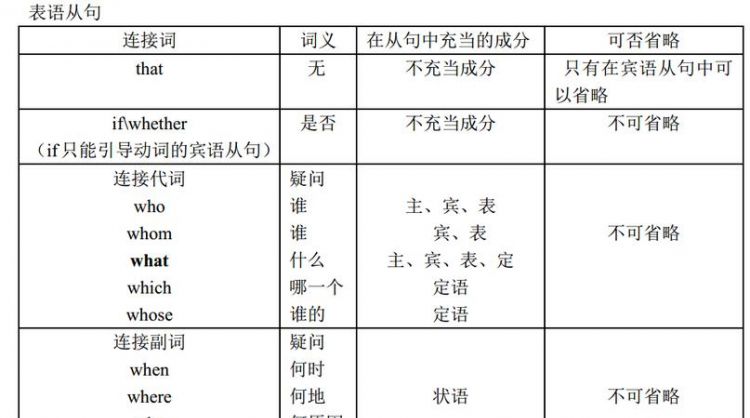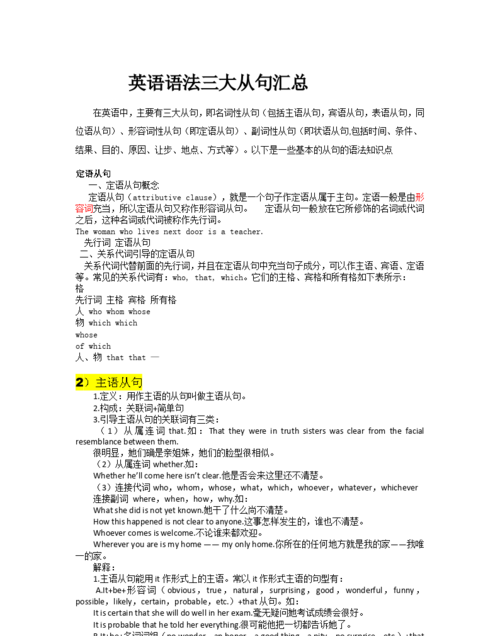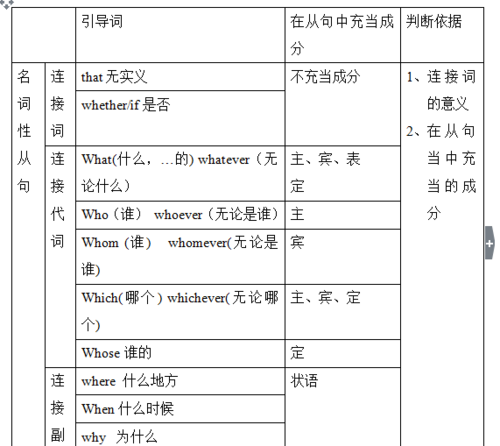本文目录
高三英语单选知识点总结归纳
高二英语 在整个高中英语中占有非常重要的地位,既是高二又是整个高中阶段的重难点,所以要保持良好的学习心态和正确的 学习 方法 。下面就是我给大家带来的 高三英语 语法知识点,希望对大家有所帮助!
高三英语语法知识点1
一、不定式做主语:
1、不定式做主语一般表示具体的某次动作。===动名词doing 表示习惯的,经常的动作。
e.g: To finish the building in a month is difficult.
To do such things is foolish.
To see is to believe. (对等)
注: 1). 不定式作主语时,谓语用单数
2). 当主语较长,谓语较短时,常用it做形式主语,而将不定式放到谓语的后面。
it做形式主语,不定式放在谓语动词之后常用于下列结构中:
(1)It is/was +adj.+of sb. to do…
(2) It is +adj.+for sb.+to do…
It is easy / difficult / hard / foolish / unwise / right / wrong / unnecessary
(3) it is +a +名词+ to do...
It is a pity / a pleasure / a pleasant thing / one’s duty / an honor / a shame / a crime / no easy job… to do
It takes (sb.) some time / courage / patience …to do…
It requires courage / patience / hard work… to do…
注意: probable 和 possible 均可作表语,但possible可以用不定式作真实主语, 而probable不能用不定式作真实主语。
It is probable for him to come to the meeting.(错)
It is possible for him to come to the meeting.
It is possible / probable that he will come to the meeting.
高三英语语法知识点2
一、非谓语动词
“非谓语动词”可分为动词不定式、动名词和分词.它在 句子 中的作用很多:除了不作谓语外,它可以充当主语、宾语、表语、定语、状语与复合宾语(主语补语或宾语补语).有些及物动词后面接不带to的不定式作复合宾语.这些动词归纳如下:一感(feel).二听(hear,listen to),三让(have,1et, make),四看(see,watCh,notice,observe).再加上help somebody(to)do something和美国英语look at somebody do somthing.还有“二让”属特殊:get somebody to do something 与keep somebody doing.而有些及物动词后面接动名词(the -ing form)作宾语.这些动词归纳为一句话:Papa C makes friends.这是由如下动词的开头字母组成:permit,advise, practise,avoid,consider,mind, allow,keep,enjoy,suggest, finish,risk,imagine,escape,need,delay,stand(忍受). 为了容易记住,也可以编成 顺口溜 :“允许完成练习,建议避免冒险,考虑延期逃跑,喜欢保持想象,需要反对忍受”.其相对应的动词依次是:permit/allow,finish,practise;
advise/suggest, avoid,risk: consider, delay, escape/miss; enjoy/appreciate, keep, imagine; need/want/require,mind. can't help/can’t stand.
二、复合句
1、学生最容易混淆的是定语从句与同位语从句的区别.
例如:A、The news that our team has won the match is true. (同位语从句)
B、The news that he told us surprised everybody here. (定语从句)
关键的区别在于连接或关系代词that:有意义的是定语, 无意义的是同位.因为引导定语从句的that在从句中作主语或 宾语,而引导同位语从句的that只起到连接词的作用.
2、接着容易混淆的是引导定语从句的关系代词that与 which:that之前是不定(代词)、序数(词)、(形容词)级:which之前是介词 短语 与逗号(非限制性).
例如:A、All that we have to do is to practise every day.
B、The first lesson that I learned will never be forgotten.
C、I have lost my pen,which I like very much.
D、The house in front of which there is a garden is my home.
三、It的用法
1、It除了代替人和物以外,还可以作形式主语.而真正的主语(不定式、动名词或从句)则放于谓语或表语之后.
例如:It is nor easy to finish the work in two days.
然而有少数表语之后接动名词作真正的主语.这些表语是:无助(no help)、无用(no use)、没好处(no good);工作(hard work)、费时(a waste of time)、又危险(a danger).
例如:A、It is no use crying over spilt milk.
B、It is a waste of time waiting for him.
2、It还可以作形式宾语.通常下列动词后面可接it作形式宾语:2f2tcjm(find,feel,think,take,consider,judge, make).
例如:A、He made it clear that he was not interested in this subject.
B、I think it no use arguing with him.
3、It用于强调句式.要强调句子的某一部分(主语、宾语、 状语),可以把it当作先行词.这种句子的结构是:It is(was)+ 被强调部分+that(who)+句子的其余部分.
例如:A、It iS Professor Lin who teaches us English—(强调主语)
B、It was in Shanghai that l saw the film.—(强调状语)
C、It was in 1990 that I worked in the factory.(同上)
但要注意与定语从句的区别.
例如:D、It was 1990 when I worked in the factory.(定语从句)
在强调句式里,我们把强调结构It is(was)…that除去,句子还很完整.如例句C.而例句D就不能.
四、倒装结构
学生容易混淆的是全部倒装与部分倒装.如何区分之,编个顺口溜:副(adv.)介(prep.)提前全倒装, 其它 句式部分倒;否定提前倒助动,让步状语倒表语;复合句式倒主句,不
倒装的属特殊.下面举例说明:
A、Here comes the bus.(副词提前,全倒装)
B、Here he comes.(代词作主语,不倒装)
C、In front of the house lies a garden.(介词短语提前,全倒装)
D、Never shall I do this again.(否定词提前,部分倒装)
E、Young as he is ,he knows a lot.(让步状语从句,表语倒装)
F、Only when he told me did I realize what trouble he was in.(only 修饰状语,主句倒装)
G、Only he can save the patient.(only修饰主语.不倒装)
H、Not only will help be given to people,but also medical treatment will be provided.(否定词提前,部分倒装)
I、Not only he but also we like sports.(连接两个主语,不倒装)
五、虚拟语气
虚拟语气也是一个难点.所谓虚拟语气是表示说话人的愿望、假设、猜测或建议,而不表示客观存在的事实.它通过句子的谓语动词的特殊形式来表示.现归纳如下:纯假设,用虚拟,动词时态退一级:条件句,分主从,主句谓语前加would (should,could,might);表愿望,用虚拟,wish后面接宾语(从句):现在过去与将来,动词时态退一级:提建议,用虚拟,宾语(从句)动词用(should)do:俩建议,三要求,再加坚持与命令(suggest,advise,demand,require,request,insist,order):It is time和eoukd rather,后接丛句用虚拟:部分主语从句中, 谓语用虚拟结构 (It is necessry /important/natural/natural/strange/strange that……should do). 下面举例说明:
A、If you came tomorrow,we would have the metting. (条件句虚拟)
B、Without air,there would be no living things.(同上)
C、We wish we had arrived there two hours earlier.(表示愿望虚拟)
D、He demanded that we (should)start right away.(表示建议虚拟)
E、It is(high)time that we left (should leave)now.(特殊从句虚拟)
F、I would rather you gave me the book.(同上)
G、It is necessary that we should clean the room everyday,(主语从句虚拟)
H、He speaks English so fluently as if he were English. (特殊从句虚拟)
高三英语语法知识点3
宾语从句就是在复合句中作宾语的名词性从句,通常放在主句谓语动词 (及物动词) 或介词之后。
1. 作动词的宾语
(1) 由that引导的宾语从句(that 通常可以省略), 例如:
I heard that be joined the army. 我听说他参军了。
(2) 由what, whether (if) 引导的宾语从句,例如:
a) She did not know what had happened. 她不知道发生了什么。
b) I wonder whether you can change this note for me. 我想知道你是否能帮我改一下笔记。
(3) 动词+间接宾语+宾语从句。例如:
She told me that she would accept my invitation. 她对我说她会接受我的邀请。
2. 作介词的宾语,例如:
Our success depends upon how well we can cooperate with one another. 我们的成功取决于我们之间的合作。
3. 作形容词的宾语,例如:
I am afraid (that) I've made a mistake. 我恐怕我已经犯了一个错误。
注意:that 引导的从句常跟在下列形容词后作宾语:anxious, aware, certain, confident, convinced, determined, glad, proud, surprised, worried, sorry, thankful, ashamed, disappointed, annoyed, pleased, hurt, satisfied, content 等。也可以将此类词后的that 从句的看作原因状语从句。
4. it 可以作为形式宾语
it 不仅可以作为形式主语,还可以作为形式宾语而真正的宾语that 从句则放在句尾,特别是在带复合宾语的句子中。 例如:
We heard it that she would get married next month. 我听说她下个朋就会结婚了。
5. 后边不能直接跟that 从句的动词
这类动词有allow, refuse, let, like, cause, force, admire, condemn, celebrate, dislike, love, help, take, forgive等。这类词后可以用不定式或动名词作宾语,但不可以用that引导的宾语从句。如:
正确表达:I admire their winning the match.
错误表达:I admire that they won the match.
6. 不可用that从句作直接宾语的动词
有些动词不可用于“动词+间接宾语+that从句”结构中,常见的有envy, order, accuse, refuse, impress, forgive, blame, denounce, advise, congratulate等。例如:
正确表达:He impressed the manager as an honest man.
错误表达:He impressed the manager that he was an honest man.
7. 否定的转移
若主句谓语动词为think, consider, suppose, believe, expect, fancy, guess, imagine等,其后的宾语从句若含有否定意义,一般要把否定词转移到主句谓语上,从句谓语用肯定式。例如:
I don't think this dress fits you well. 我认为这件衣服不适合你穿。
表语从句
表语从句在复合句中作表语的名词性从句,放在系动词之后,一般结构是“主语+连系动词+表语从句”。可以接表语从句的连系动词有be, look, remain, seem等。引导表语从句的that常可省略。另外,常用的还有the reason is that… 和It is because 等结构。例如:
1) The question is whether we can make good preparation in such a short time.
2) This is why we can't get the support of the people.
3) But the fact remains that we are behind the other classes.
4) The reason he is late for school is that he missed the early bus.
同位语从句
同位语从句就是在复合句中作名词的同位语的名词性从句。
1. 同位语从句的功能
同位语从句对于名词进一步解释,说明名词的具体内容,一般由that引导,例如:
1) The king's decision that the prisoner would be set free surprised all the people.
2) The order that all the soldiers should stay still is given by the general.
2. 同位语在句子中的位置
同位语从句有时可以不紧跟在它所说明的名词后面,而是被别的词隔开。例如:
He got the news from Mary that the sports meeting was put off.
3. 同位语从句与定语从句的区别
(1) 定语从句中的that既代替先行词,同时以在从句中作某个成分(主语或宾语),而同位语从句中的that是连词,只起连接主句与从句的作用,不充当句中任何成分。
(2) 定语从句是形容词性的,其功能是修饰先行词,对先行词加以限定,描述定的性质或特征;同位语从句是名词性的,其功能是对名词进行补充说明。例如:
1) The news that he told me is that Tom would go abroad next year.(他告诉我的消息是汤姆明年将 出国 。)(第一个that引导的从句是定语从句,that在从句中作宾语)
2)The news that Tom would go abroad is told by him.(汤姆将出国的消息是他讲的。)(同位语从句,that在句中不作任何成分)
高三英语语法知识点相关 文章 :
★ 高三英语语法知识点归纳汇总
★ 高三英语语法知识点
★ 高三英语语法知识点小结
★ 高三英语语法知识点高效总结
★ 高考英语语法知识点
★ 高考英语语法知识点
★ 高中英语语法知识点整理总结
★ 高考英语语法与知识点整理
★ 高考英语必考语法知识点
var _hmt = _hmt || []; (function() { var hm = document.createElement("script"); hm.src = "***/hm.js?3b57837d30f874be5607a657c671896b"; var s = document.getElementsByTagName("script")[0]; s.parentNode.insertBefore(hm, s); })();
名词性从句知识点归纳
名词性从句相当于名词,可分别作主句的主语、表语、宾语和同位语。因此,名词性从句可分为主语从句、表语从句、宾语从句和同位从句。
一、引导名词性从句的连接词
1. 连接代词:who, whose, whom, what, which.有词义,在从句中担任成分,如主语、表语、宾语、或定语等。
2. 连接副词:when, where, why, how.有词义,在从句中担任成分,作状语。
3. 连接词:that, whether, if, as if.that 无词义,在从句中不担任成分,有时可省略;if (whether), as if虽有词义,但在从句中不担任成分。
注意:连接代词与连接副词在句中不再是疑问句,因而从句中谓语不用疑问式。连接代词与连接副词在从句充当句子成分,连接词whether 和if(是否),as if(好像)在从句中不充当句子成分,只起连接作用。根据句义,如果连接代词与连接副词,whether、if 和as if都用不上时,才用that作连接词(that本身无任何含义)。
二、主语从句
1. 主语从句在复合句作主语。
e.g. Who will go is not important.
2. 用it作形式主语,主语从句放在句末。
e.g. It doesn‘t matter so much whether you will come or not.
3. that引导主语从句时,不能省略。
e.g. That he suddenly fell ill last week made us surprised.
三、表语从句
1. 表语从句在复合句中作表语,位于系动词之后。
e.g. The question was who could go there.
2. 引导表语从句的连接词that有时可省去。
e.g. My idea is (that) we can get more comrades to help in the work.
四、宾语从句
1. 宾语从句在复合句中作宾语。引导宾语从句的连词that一般可省略。
e.g. I hope (that) everything is all right.
2. 介词之后的宾语从句,不可用which或if连接,要分别用what或 whether.
e.g. I’m interested in whether you‘ve finished the work……
I’m interested in what you‘ve said.
3. whether与if都可以引导宾语从句,常可互换。但下面情况不能互换。
(1)宾语从句是否定句时,只用if,不用whether.
e.g. I wonder if it doesn’t rain.
(2)用if 会引起误解,就要用whether.
e.g. Please let me know whether you want to go.(此句如果把whether改成if,容易当成条件句理解)
(3)宾语从句中的whether 与or not直接连用,就不能换成if;不直接连用,可换。
e.g. I don‘t know whether or not the report is true.
I don’t know whether/ if the report is true or not.
(4)介词后的.宾语从句要用whether引导。whether 可与不定式连用。whether也可引导主语从句、表语从句、同位语从句,还可引导让步状语从句,以上均不能换成if.但引导条件从句时,只能用if,而不能用whether.
e.g. It depends on whether we have enough time.
They don‘t know whether to go there.
Please come to see me if you have time.
五、同位语从句
同位语从句在句中作某一名词的同位语,一般位于该名词(如:news, fact, idea, suggestion, promise等)之后,说明该名词的具体内容。
e.g. I have no idea when he will be back.
The fact that he had not said anything surprised everybody.

英语八大从句类型与用法总结图
从句,即从属子句,是复句中具有分属地位的分句,它是一种绝大部分语言都有的语法结构。在现代汉语的语法中,“从句”不作为专业术语被使用。在现代英语的语法中,从句指复合句中不能独立成句,但具有主语部分和谓语部分,由that、who、whom、when、why、where、how、whether、which等引导词(Connective)引导的非主句部分。
从句用法总结
1.主语从句
1)主语从句可直接位于主语的位置,如果从句较长,谓语又较短,可用it作形式主语,而将从句放在句末。常见的句型有:
*It is a fact\a pity\a question\good news that...
*It seems\appears\happened\has turned out that...
*It is clear\important\likely\possible that...
*It is said\reported\estimated\has been proved that...
It is said that comic books create a connection between people of the same generation.
It seems that the performance is very useful.
2)what引导的主语从句表示“...的东西时”,一般不用it作形式主语。
What we lack is experience.
3)what,who,when,why,whether等词含有各自的疑问意义,但它们引导的主语从句,都用陈述语序。
How the plan is to be carried out should be discussed again.
I did know why I felt like crying.
2.宾语从句
1)宾语从句可位于及物动词、介词和某些形容词后。连词that常可省略。介词后一般接疑问词引导的宾语从句。in that(因为),except that(除了),but that(只是)已构成固定搭配,其他介词后一般不接that引导的宾语从句。
*I promised that I would change the situation.
*All this is different from what American young people would say about friendship.
*He is certain that watching so much television is not good for children.
*This article is well-written except that it is a bit too long.
2)宾语从句后如有宾补,要用形式宾语it来代替,而把宾语从句移至宾补之后。
He has made it clear that he would not change his mind.
3)在think,believe,suppose,expect等动词后的宾语从句中,如果谓语是否定的,一般将否定词移至主句谓语上,宾语从句则变成肯定形式。
He didn't think that the money was well spent.
3.表语从句
表语从句出现在结构为“主语+系动词+表语从句”的句子中。表语从句除可用that,what,when,why,whether,how等引导外,还可由because,as if(though)等引导。that常可省略。如主句主语为reason,只能用that引导表语从句,不可用because.
Perhaps the most important thing to remember is that there is no one common type of life in America.
The reason why so many people died there is that there were not enough food supplies.
It looks as if successful international cultural communication will make the world smaller.
4.同位语从句
同位语从句用于对前面出现的名词作进一步说明,一般用连词that引导,由于先行名词的意义不同,也可用whether,who,when,where,what,why,how等引导。常见的先行名词有fact,idea,belief,news,hope,conclusion,evidence,suggestion,order,problem,report,decision.有时由于谓语较短,将同位语从句位于谓语之后。
She finally made the decision that she would join the fashion show.
I had no idea how many books I could borrow at a time.
The news came that their team had won the championship.
5.定语从句
定语从句所修饰的先行词可以是名词或代词,也可以是一个句子。定语从句通常位于先行词之后,由关系代词或关系副词引导。
*限制性定语从句
限制性定语从句修饰先行词,对先行词起修饰作用,紧接先行词之后,无逗号,若省去,原句意思不完整。引导定语从句的关系代词有who,whom,whose,which,that等。who,whom,whose用于指人,whose有时也可指物,相当于of which;which用于指物;that既可指人也可指物,但只用于限制性定语从句中。关系代词除了引导定语从句,替代先行词外,还在从句中担任主语、宾语、定语等。
The computers and cables which make up the Internet are owned by people and organizations.
Those who live alone or who are sick may have trouble in getting close to other people.
The girl whose parents died in an accident is living with her grandmother.
1)当先行词是all,anything,everything,something,nothing等不定代词或先行词前有first,last,any,few,much,some,no,only以及形容词最高级修饰时,只能用关系代词that引导从句。
That is all that I've heard from him.
He's the first person that I'm going to interview this afternoon.
2)关系代词的省略
在从句中作宾语的关系代词常可省略。关系代词紧跟介词,作介词宾语时不可用that,只可用which或whom引导从句,并且不可省略,但当介词位于宾语从句句末时,作为介词宾语的关系代词仍可用that,也可省略。
This is one of those things with which we have to put up.
This is one of those things (which\that) we have to put up with.
3)引导定语从句的关系副词有when,where,why等。关系副词在从句中作状语,意义上相当于一个“介词+which”的结构。
Even in comic books where(=in which) there are no words,the stories are fully expressed through the drawings.
No one knows the reason why(=for which) he was so angry that day.
5.定语从句
*非限制性定语从句
非限制性定语从句既可修饰先行词,也可修饰整个主句,起补充说明作用,与主句之间有逗号隔开,若省去,原句意思不受影响。不可用that引导非限制性定语从句。关系词不可省略。
Every object has a gravitational pull,which is rather like magnetism.
*“介词+which\whom\whose”引导的定语从句
“介词+which\whom\whose”可引导限制性定语从句,也可引导非限制性定语从句,该结构中介词的选择取决于从句谓语动词的固定搭配,或先行词的习惯搭配。
This is the computer on which he spent all his savings
It is written by a person with whom we are all familiar.
*as引导的定语从句
as引导的定语从句主要用于“such...as”及“the same...as”的结构中,代替先行词是人或物的名词。as引导非限制性定语从句时,代替整个主句,从句可位于主句之前、之后或中间。
These are not such problems as can be easily solved.(as代替先行词problems)
As is mentioned above,no single company or group can control what happens on the Internet.(as代替主语)
英语八类状语从句的用法归纳
一、概说
状语从句即指在主从复合句用作状语的从句。按照其意义,状语从句可分为时间状语从句、地点状语从句、原因状语从句、目的状语从句、结果状语从句、条件状语从句、让步状语从句等。状语从句是高中英语学习中的一个语法重点,也是历年高考重点考查的内容之一。学习状语从句主要应注意引导状语从句的从属连词的用法与区别,以及从属连词在一定的语言环境中的意义与用法。
二、时间状语从句
1.引导时间状语从句的从属连词很多,常见的有before,after,when,while,as,since,till,until,assoonas等。
2.表示“当…时候”的while,when,as的用法区别是:while从句中的谓语动词必须是延续性动词;表示带有规律性的“每当”或当主、从句谓语动词的动作发生有先后时,只能用when;当表示“一边…一边…”或“随着”时,只能用as。另外,用于此义的as所引导的时间状语从句谓语只能是动作动词,不能是状态动词。如下面一道高考题的答案是B而不能是A:
“I’mgoingtothepostoffice.”“_____you’rethere,canyougetmesomestamps?”
A.As B.While C.Because D.If
3.until在肯定句中通常只连用延续性动词,表示相应动作结束的时间;在否定句中通常连用非延续性动词,表示相应动作开始的时间,意为“直到…才”。如:
Hewaiteduntilshewasabouttoleave.他等着一直到她准备离开。
Ididnotbegintoworktillhehadgone.他走了后我才开始工作。
4.表示“一…就”除用assoonas外,还可用theminute,thesecond,theinstant,immediately,directly,instantly,nosooner…than,hardly…when等。如:
Icameimmediatelyyoucalled.你一来电话我就来了。
Hardlyhadshearrivedwhenitbegantosnow.她刚到就下起雪来了。
ThemomentIhavefinishedI'llgiveyouacall.我一干完就给你打电话。
5.everytime,eachtime,(the)nexttime,(the)lasttime,bythetime,thefirsttime,anytime等以time结尾的词语也可用作连词,引导时间状语从句。如:
Nexttimeyoucomein,pleaseclosethedoor.下次你进来,请关门。
Hedidn’ttellmeanythingthelasttimeIsawhim.上次我见到他时他什么也没告诉我。
BythetimeIgothome,shehadalreadygonetobed.我到家时她已睡觉了。
三、条件状语从句
1.引导条件状语从句的从属连词主要有if,unless,as[so]longas等。如:
Don’tcomeunlessItelephone.除非我打电话,否则你别来。
Ifyouwatchcarefullyyouwillseehowtodoit.如果你仔细瞧你会看出该怎样做。
Aslongasyoudoyourbest,we’llbehappy.只要你尽力,我们就满意了。
2.incase也可引导条件状语从句,其意为“如果”、“万一”。如:
IncaseIforget,pleaseremindmeaboutit.如果我忘了,请提醒我。
四、让步状语从句
1.引导让步状语从句的从属连词主要有although,though,however(=nomatterhow),evenif(即使),whether…or(不论…还是)等连词。如:
Thespeechisgood,thoughitcouldbebetter.这次演讲不错,虽然还可以再好一点。
Hewentouteventhoughitwasraining.尽管下雨,他还是出去了。
2.as也可引导让步状语从句,但要将名词、形容词或副词等提到as前,若提前的是单数可数名词,要省略a/an。如:
Teacherasheis,hecan’tknoweverything.虽然是老师,他也不可能什么都懂。
3.连词while有时也可表示“尽管”、“虽然”,引导让步状语从句。如:
Whilewedon’tagreewecontinuetobefriends.尽管我们意见不同,我们还是朋友。
4.whatever,whoever,however,whenever,wherever等引导让步状语从句。如:
Don’tloseheartwhateveryoudo.不管你做什么,都不要灰心。
Whoeveryouare,youcan’tpassthisway.不管你是谁,你都不能从这里通过。
注:表示“虽然”的though,although不可与but连用,但可与yet,still连用。
五、原因状语从句
1.引导原因状语从句的从属连词主要有because,as,since,seeing(that),now(that)等:
Theycan’thavegoneoutbecausethelight’son.他们不可能出去了,因为灯还亮着。
Sinceyouaregoing,Iwillgo.既然你去,我也去。
Nowthatwearealone,wecanspeakfreely.现在我们单独在一起,可以随便谈了。
2.除以上提到的大家比较熟悉的引导原因状语从句的从属连词外,when有时也可引导原因状语从句,其意“既然”。如:
Ican’ttellyouwhenyouwon'tlisten.既然你不想听,我就不告诉你了。
3.有关原因状语从句还应注意以下几点:
(1)as与since,nowthat一样表示双方都知道的原因,通常位于主句前,且均不可用于强调结构被强调。
(2)当表示直接的因果关系,回答why时,或有only,just,all,partly,not,but等副词修饰时,或用在强调结构中都只能用because。
(3)for有时也可引出表示原因的分句,但它只能位于后面,对前一分句加以解释或推断。
(4)不要受汉语意思影响将表示“因为”的连词与表示“所以”的so连用。
六、地点状语从句
引导地点状语从句的从属连词主要有where(在…的地方),wherever(无论什么地方),everywhere(每个…地方),anywhere(任何…地方)。如:
I’mnotlivingwhereIwas.我不在原处住了。
Youcan’tcampwhere[wherever,anywhere]youlikethesedays.如今你可不能随便在哪儿宿营。
EverywhereIgo,Ifindthesamething.不管我走到哪里,我都发现同样情况。
2.有的同学认为地点状语从句在平时见得不多,误认为考试不会涉及,但恰恰相反,地点状语从句却是英语考试经常考查的一个知识点。请看以下考题:
(1)Whenyoureadthebook,you’dbettermakeamark_____youhaveanyquestions.
A.atwhich B.atwhere C.theplacewhere D.where
(2)Afterthewar,anewschoolbuildingwasputup_____therehadoncebeenatheatre.
A.that B.where C.which D.when
(3)Youshouldmakeitaruletoleavethings_____youcanfindthemagain.
A.when B.where C.then D.there
(4)Shefoundhercalculator______shelostit.
A.where B.when C.inwhich D.that
以上四题均选where,其意为“在…的地方”,用以引导地点状语从句。
七、目的状语从句
1.引导目的状语从句的从属连词主要有inorderthat,sothat,incase,forfear等。如:
IhiredaboatsothatIcouldgofishing.我租了一条船去钓鱼。
Takeyourcoatincaseitrains(shouldrain).带着雨衣以防下雨。
Hestudiedhardinorderthathecouldpasstheexam.他努力学习,是为了能通过考试。
2.引导目的状语从句的sothat有时可省so或that,即单独用so或that来引导目的状语从句。如:
Checkcarefully,soanymistakewillbecaught.仔细检查,以便任何错误都可检查出。
BringitcloserthatImightseeitbetter.拿近些,使我能看得清楚些。
八、结果状语从句
引导结果状语从句的从属连词主要有sothat,so…that,such…that等。如:
Hewassoangrythathecouldn'tspeak.他气得话都说不出来。
Heshutthewindowwithsuchforcethattheglassbroke.他关窗子用力很大,结果玻璃震破了。
注:so…that和such…that中的that有时(尤其在口语中)可省略。

初三定语从句专练题及答案
从句分为1,定语从句,2 ,名词性从句,3,状语从句
定语从句,以一个句子作为定语的成分。可分为限制性定语从句和非限制性定语从句。定语:用来修饰名词,代词的词,比如形容词,She is a beautiful girl.这里的beautiful在句中就做定语成分。
定语从句需注意两个,一,先行词。二,引导词。先行词即指,被修饰的那个词,通常是由名词和代词充当。比如,My friend is a girl who is very beautiful.在这句中,先行词就是“girl ”,who is very beautiful.是定语从句,用于修饰girl。、
关系代词 :
二,引导词
关系副词
关系代词:1,that (先行词是人或物,在句中做主语或宾语成分,作宾语时可省略)
2, which(先行词是物,在句中做主语或宾语成分)
3, whose(先行词人或物,在句中与先行词是所属关系,表示……的)
4, who (先行词是人,在句中做主语成分)
5, whom(先行词是人,在句中做宾语成分)
关系副词:1, when (先行词是表示时间的名词或代词,如,day, Monday…..引导一个完整的句子,在句中不做任何成分)
2, where (先行词是表示地点的名词或代词,如,place, school…..引导一个完整的句子,在句中不做任何成分)
Where=in which
3,why (先行词是表示原因的词,比如reason,PS:一般主要是修饰reason 。引导一个完整的句子,在句中不做任何成分)
Why=for which
只能用that,不能用which。、
常见的情况有下列五种:
1、当先行词是:all , any , anything , everything , nothing或被它们修饰时。例如:
Is there anything that I can do for you?
有什么可以为你做的吗?
All that can be done must be done.
凡是能做的都必须做。
2、当先行词被形容词的最高级或序数词修饰时。例如:
That is one of the most interesting books that are sold in the bookshop.
那是这家书店出售的最有趣的书之一。
The first thing that we should do is to get some food.
我们该做的第一件事是弄点吃的。
3、当先行词有:the only , the very , the same , the last 等修饰时。例如:
My necklace is not the only thing that's missing.
我的项链不仅是丢掉的东西。
4、当主句以who或which开头时,定语从句中引导词用that ,不用which 或who 。以避免重复。例如:
Who is the girl that is wearing a red coat?
正穿一件红色外套的女孩子是谁?
5、当先行词既有人又有物时,用that 。例如:
The writer and his novel that you have just talked about are really well known.
你刚才谈起的那位作家以及他的小说确实很著名。
非限制性定语从句:
只需要把握,在非限制性定语从句的前面往往有逗号隔开
将整个主句作为先行词, 对其进行修饰, 这时从句谓语动词要用第三人称单数
如:This novel, which I have read three times, is very touching
PS:在非限制定语从句中,当先行词是一个句子时,不能用“that”来引导
二,名词性从句
名词性从句包括:主语从句,宾语从句,表语从句。在名词性从句中,没有先行词,但是有连接词,连接代词,连接副词。
1. 宾语从句:以一个句子充当宾语,放在动词或介词的后面。
连接词: that(不做任何成分,无含义,可省略。)
如: I say (that) he will come back tomorrow.
whether(不做成分,含义为是否),一般与“or not”
连用,如:
I don’t know whether it is right or not.
if(表是否,不做成分)
I don’t know if it is right .
连接代词:what(什么),who(谁,作主语),whatever(无论什么),whom(谁,作宾语),whose(谁的),which(哪一个)。 Whoever(无论谁),whichever(无论哪一个)这些词在句中坐成分,并有具体含义。注意,句子是陈述语序
连接副词:where(在哪儿)when(什么时候)why(为什么)
how(怎么样) whenever(无论何时)
wherever(无论何地)however(无论怎样)
这些 副词有具体含义,但在句中不做成分,后接完整的句子,注意,句子是陈述语序
如:She asks when you will get it
完整句子,有主语,谓语,宾语并且,此句子是陈述语序
二,表语从句,以一个句子充当表语。和宾语从句差不多,但注意,这是以一个句子充当表语,就要先弄清楚什么是表语,表语就是系动词后的词。又引出来一个,什么是系动词,这个自己去百度Google一下哈。
三,主语从句。以一个句子充当主语。这个也和并与从句差不多,但就是第一个,当一个句子充当主语时,若此句子成分完整,则需要在句子句首加上连接词“that”没有任何含义,但不能省略!其他的都和宾语从句差不多。
如:That it was a bird surprised us.
it was a bird 是一个完整的句子,有主语,谓语,宾语
主语从句,充当整个句子主语

以上就是关于表语从句知识点总结,高三英语单选知识点总结归纳的全部内容,以及表语从句知识点总结 的相关内容,希望能够帮到您。
